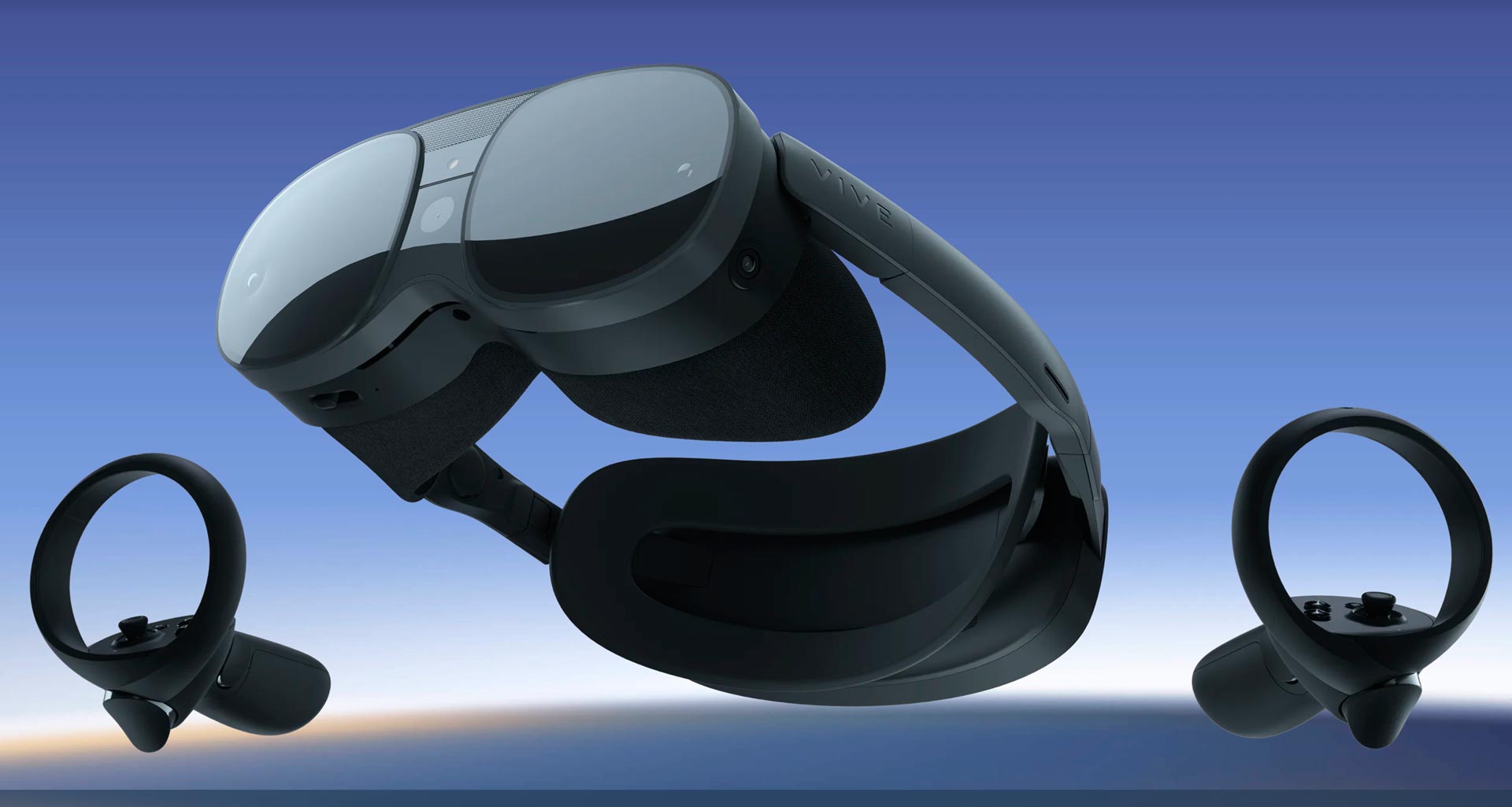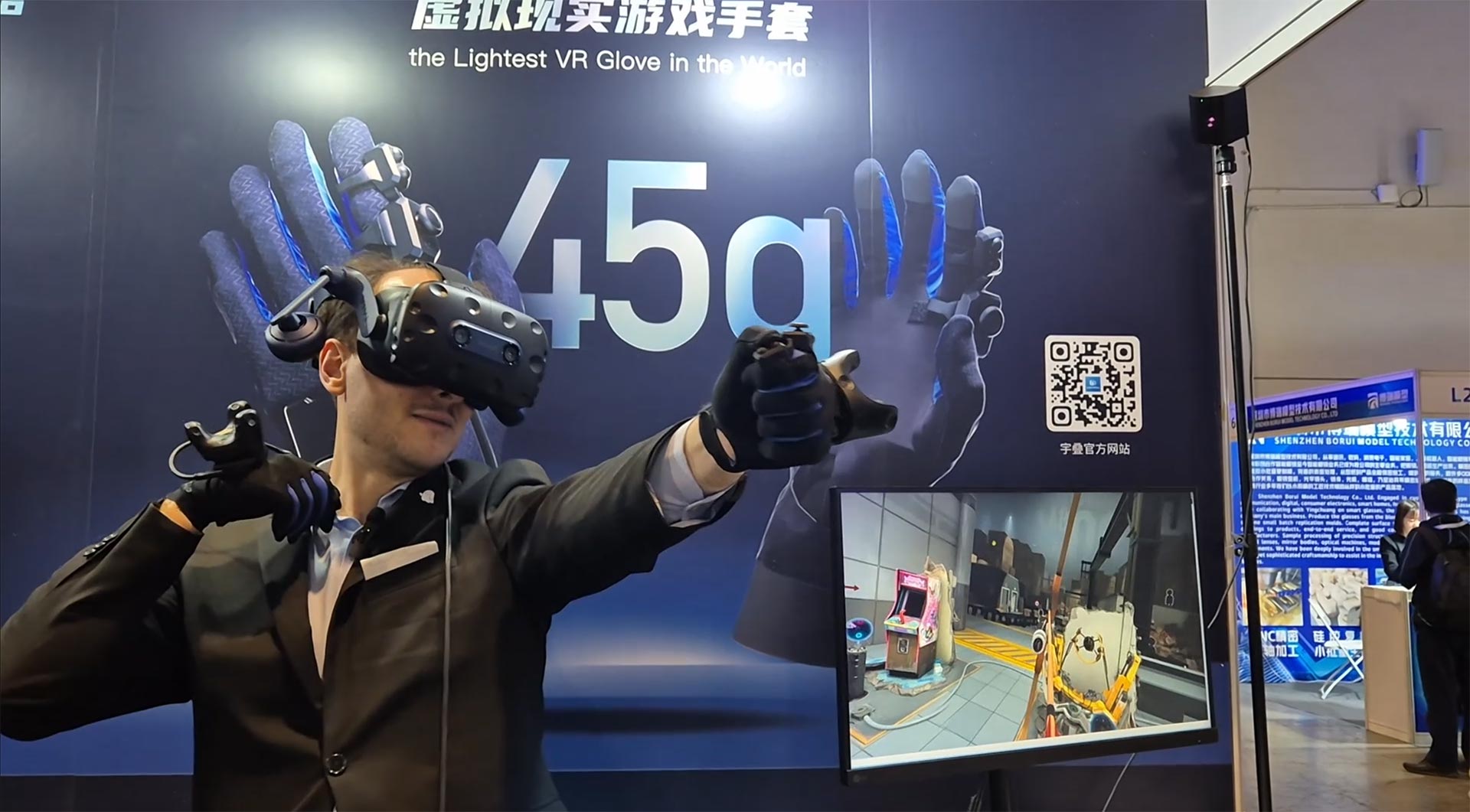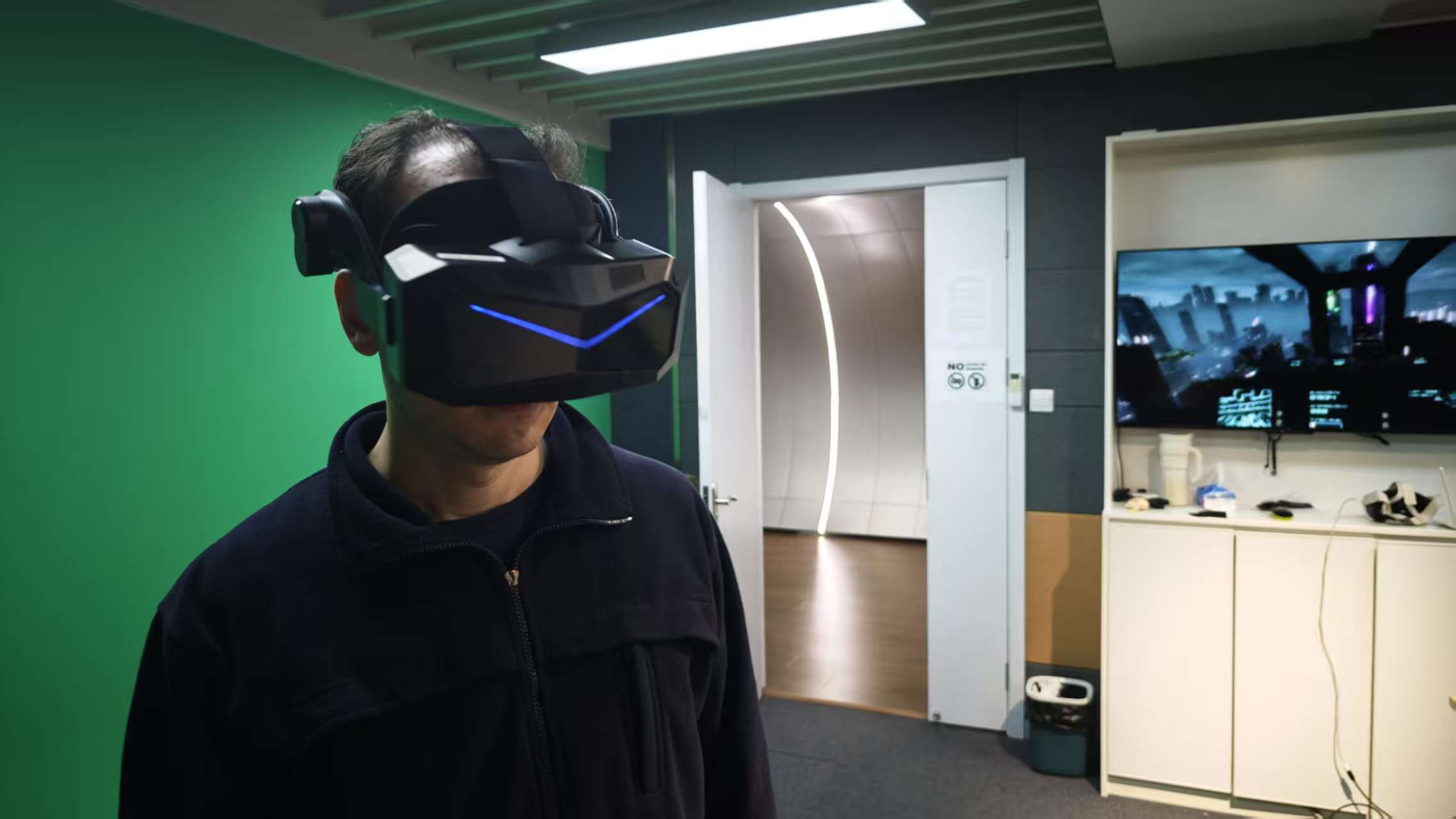A few thoughts on the Vive XR Elite
One of the most important XR news from CES has been the reveal by HTC of the Vive XR Elite. I’ve always published news articles about the release of all the most recent HTC headsets, but this time I wasn’t at CES and I hadn’t received any kind of press material from the company, so I had no way to write a meaningful article about it in time. I’ve so waited a few days to become more informed about the device to be able to write some thoughts about it. I hope my reasonings will help you in understanding better the headset and the current XR ecosystem in general.
Vive XR Elite
I’m pretty sure you have already read the news about the announcement of the Vive XR Elite. In case you missed it, I can summarize it by saying that HTC launched a new Quest Pro competitor priced at $1100. It misses some of the features of the Quest Pro, like face and eye tracking, but it introduces other ones, like a very small form factor and the addition of a depth sensor, which can be used in the future for things like room scanning and mapping. The headset is standalone, and has the battery on the back, but it can also work by removing the battery and connecting the glasses to an external power source. HTC considers it to be a consumer device, and it claims that many popular VR games are coming for it, like Demeo, Unplugged, Green Hell VR, Les Mills Bodycombat, and many others. The Vive XR Elite is officially being shipped in February.
Here you are its main specs:
- 1920*1920 pixels per eye
- Up to 110 degrees FOV
- 90Hz display
- Qualcomm® Snapdragon™ XR2 chipset
- 128GB storage
- 12GB RAM
- USB/Wi-Fi/Bluetooth connectivity
- Hot-swappable and removable battery
- Support for 6DOF controllers and hand tracking
If you want to read more about it, I suggest reading this article on UploadVR: https://uploadvr.com/htc-vive-xr-elite/
In the remainder of the article, you will find some thoughts of mine about it.
Super small size
Let me start with the size of the device, which is incredibly small. This picture I found today on Facebook struck me in showing how the Vive XR Elite is able to provide many features in a very compact form factor.

The Vive XR Elite is very small, and it is especially compact to be a standalone device. I’ve seen other small headsets (like MeganeX or the Huawei VR), but usually, they worked by being connected to a PC or a phone. This one is a full standalone running out of an XR2, and it is rather impressive to see the size it has. Big kudos to HTC for this.
A small factor also means better comfort… theoretically. The headset is small and light and this helps for comfort, but the fact that it misses a top headband also means that the weight should all be distributed between the nape, the ears, the forehead, and the nose. I’m not totally sure it can work for long-term usage, especially after my negative experience with the Quest Pro that every time makes my forehead become totally red. Unluckily, no one at CES could try it for enough time to express a reliable judgment on the topic. First reviewers say that in demos it feels comfortable, though, so fingers crossed it is also over time.
Parts Recycling
This headset confirms the trend that HTC has in recycling parts of other previous headsets to create new ones, so that to be more efficient in the production pipeline. For instance, the Vive Pro 2 seemed like a mix of the Vive Pro 1 and the Vive Focus 3. This headset instead seems a mix of the Vive Flow and the Focus 3: the glasses design is almost identical to the one of the Flow, while the controllers are the same as the Focus 3. This is why Brad Lynch called it “The Flowcus”.

On one side, I think this is a smart idea to make the company more money-efficient. On the other side, sometimes I have the impression it could innovate even more if every component could be thought in a total independent way from the previous headsets.
Mixed reality, again
The trend of the moment is making virtual reality headsets that also support passthrough augmented reality, and the Vive XR Elite does the same for all its competitors. First reviewers claim that the passthrough quality seems really high, especially for what concerns resolution and dynamic range, but Sebastian Ang that tried it directly at the launch event in Taipei highlights that passthrough has not the same good depth and stereo correction as the Quest Pro. It looks so flatter and more zoomed than it should be, like the one of the Pico 4.
Vive XR Elite has anyway an exciting feature that the Quest Pro is missing and it is the depth sensor. Its data could be useful for two purposes:
- It could be fused with the information read from the RGB cameras so that to give better depth to the passthrough vision
- It could be used to reconstruct the model of the room where the user is in so that to improve the tracking and also to create a much more powerful mixed reality. The headset in the future could detect where the walls, the desks, and other similar features of the room of the user are, and the developers could use it to make mixed reality experiences that blend better the virtual and the real. This could be pretty cool.
Consumer-prosumer mismatch

This headset anyway also takes part in the current trend of creating confusion between consumer and enterprise-oriented headsets. To be totally honest, this is a trend that HTC started before the others :P, but now other companies like Meta joined it. The only company which is clearly separating its production lines is currently Pico.
The Vive XR Elite costs $1100, but it is intended to be also a consumer device. For this reason, HTC talks about the games that will be available for it at its launch. But honestly, at $1100 almost no consumer will buy it. I was there when VR started, and when headsets cost around $1000, only we nerds and professionals were buying them. We saw that price was important factor for the success of XR devices a lot of times these years, and I’m ready to bet that at $1100 this will never be a commercial success amongst average consumers. It’s the same thing we all said about the Quest Pro: it’s too expensive for consumers. HTC claims that there is room for pro users and talks about the Nintendo Switch Pro, but the fact is that devices for which there is a Pro version, like the Switch or the iPhone, are devices with already existing commercial success, and for which companies are trying to step up the game. VR headsets are still very niche, so its pro users are a niche of a niche.
Also the intended cool features like mixed reality, room scanning, etc… are nothing that the VR users are asking about. These are features that prosumers, developers, and companies are asking for. And also the price is in line with prosumer/enterprise… and so is the reputation of HTC. So I will personally consider this a prosumer/enterprise device and that’s it.
Changeable form factor
One of the coolest features of the Vive XR Elite is that you can remove the back battery and transform the headset into just big glasses connected to a power bank, or maybe connected to the PC for PCVR.
I love the idea, I think it makes the headset more versatile. It is also super original.
At a second glance, though, I spotted a few problems with it. The first is that no one ever asked for it.
The second is friction: when I want to use my Quest 2 as a PCVR device, I find it very boring that I have to take a USB cable, plug it in, and then activate the Link from the menu. Users are lazy, and I’m the laziest of them.
Imagining that I have to every time press two buttons, detach the battery and store it idontknowwhere, then take the end of glass frames from Idontknowwhere and plug them into the frames, then attach the external battery to the USB port seems too boring to do it frequently. I think that in the end users will stick with one of the two modes and stay with it most of the time. I love the idea, but I think in the long run the process should be more streamlined.
The third problem is that without the battery in the back, the big pair of glasses become more front heavy, so unbalanced. And without the crown securing them to your nape, they become also a bit unstable. Sebastian Ang underlines this in his hands-on, in fact.
Modularity
The headset doesn’t come with eye and face tracking out of the box like the Quest Pro, but they will be available in the future via a dedicated accessory. I’ve always praised the modularity of Vive headsets and I think that this can be a winning choice: only the users really wanting these sensors should pay for them, while the others this way can have a cheaper headset.
Display
When teasing the headset, HTC claimed the Vive XR Elite has a better dynamic range than the competition. Watching the hands-on by Sebastian Ang, I saw him not being excited by the visuals. I mean, they were good, but in line with the competitors of this device.
Content
It’s years that the community is asking for more content more than improved hardware. So this headset is nice, but is it bringing enough content to make it interesting for consumers? The fact that it is OpenXR-compatible is helping it to have more portings, but this is still to be discovered.
Glasses support

The lenses of the device support diopter adjustment: it means that you can set up your diopter data directly into the device, so you don’t need to wear glasses when using it because the vision will be automatically corrected by it. This is amazing for all glass wearers. The only problem is: if you have a too-big diopter adjustment required, the headset can’t correct for it but at the same time it is too small to fit your glasses. This is the problem that CNET’s Scott Stein found when going hands-on with it.
Should you buy it?

At this point, you may be wondering if you should buy it or not. Well, I haven’t tried the headset, so I don’t know. The first hands-on are quite positive, so it seems a good headset, but VR headsets can be reviewed only after extensive usage, so I can’t tell you now if it is worth spending $1100 or not.
What is clear to me is that it is not a consumer device: if your plan was buying a Quest 2 or a Pico 4 to play games like Demeo and Beat Saber, I don’t think you need to spend more than 2x the price to buy this headset. You will never use its special features and paying much more for some added comfort is not worth the price, IMHO.
On the other side, if you are a prosumer or a company and you were evaluating buying the Quest Pro or the Pico 4 Enterprise, then you should absolutely consider this headset. If you make extensive usage of VR for long times, you should evaluate it, too, because the added comfort over hours may be beneficial for your wellbeing. Its form factor with the detached battery makes it also very suitable to be used in lying mode. Also if you are a developer that wants to experiment with passthrough AR and environment understanding, you should be interested.
But if you want me to tell you if it is better this or the Quest Pro or the Pico 4 Enterprise, I have no idea because I don’t have this headset. As a quick rule of thumb, this is what I have in my mind FOR NOW, though:
- Best price: Pico 4 Enterprise. It costs $900 + VAT, so less than the other two.
- Best enterprise Features: Pico 4 Enterprise. It’s a headset with the purpose of serving only companies, so it has the clearest offering. I’m sure that anyway also the Vive XR Elite has good business offering because Vive historically has always been good for that. It’s just that this plan is not clear to me at this moment.
- Most interest for developers: it’s a tie. Meta provides the best eye and face tracking, Vive has depth sensor, Pico gives access to the camera image stream. Pick what’s interesting for you.
- Best controllers: Meta Quest Pro. Its latest controllers are very innovative and ergonomic.
- Best comfort: theoretically Vive XR Elite. It is the smallest of the headsets, so theoretically it is the most comfortable.
- Best performances: it’s a tie. All are based on XR2, the Quest Pro on XR2+, but it has more sensors to power.
- Best mixed reality: Quest Pro and Vive XR Elite. Quest has the best 3D reconstruction, but Vive XR Elite has the ace in the sleeve of the depth sensor.
These are just some hints, don’t take them as a shopping guide. I will be able to provide better insights after I will go hands-on with the device.
Final thoughts
I think that the Vive XR Elite is a good device that inserts in a historical moment in which in XR everyone tries to release small headsets featuring mixed reality dedicated to prosumers. The first opinions about it are good, now let’s wait and see what will happen when it will be released in the wild.
(Header image by HTC Vive)
Disclaimer: this blog contains advertisement and affiliate links to sustain itself. If you click on an affiliate link, I'll be very happy because I'll earn a small commission on your purchase. You can find my boring full disclosure here.



